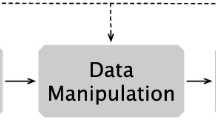Abstract
The design of data warehouses (DWs) is based on both their data sources and users’ requirements. The more closely the DW multidimensional schema reflects the stakeholders’ needs, the more effectively they will make use of the DW content for their OLAP analyses. Thus, considerable attention has been given in the literature to DW requirements analysis, including requirements elicitation, specification and validation. Unfortunately, traditional approaches are based on complex formalisms that cannot be used with decision makers who have no previous experience with DWs and OLAP. This forces a sharp separation between elicitation and specification. To cope with this problem, we propose a new requirements analysis process where pivot tables, a well-known representation for multidimensional data often used by decision makers, are enhanced to be used both for elicitation and as a specification formalism. A pivot table is a two-dimensional spreadsheet that supports the analyses of multidimensional data by nesting several dimensions on the x- or y-axis and displaying data on multiple pages. The requirements analysis process we propose is iterative and relies on both unstructured and structured interviews; particular attention is given to enable the design of irregular multidimensional schemata, which are often present in real-world DWs but can hardly be understood by unskilled users. Finally, we validate our proposal using a real case study in the biodiversity domain.
















Similar content being viewed by others
References
Arnold D, Corriveau J, Shi W (2010) Modeling and validating requirements using executable contracts and scenarios. In: Proceedings eighth ACIS international conference on software engineering research, management and applications, pp 311–320
Benker T, Jürck C (2012) A case study on model-driven data warehouse development. Proc DaWaK 2012:54–64
Bimonte S, Edoh-Alove E, Nazih H, Kang M, Rizzi S (2013) ProtOLAP: rapid OLAP prototyping with on-demand data supply. In: Proceedings of the sixteenth international workshop on data warehousing and OLAP, ACM, pp 61–66
Bimonte S, Sakka A, Sautot L (2018) A new methodology for elicitation of datawarehouse requirements based on the pivot table formalism. In: Proceedings of 14eme edition de la conference EDA, pp 263–272
Bimonte S, Rizzi S, Sautot L, Fontaine B (2019) Volunteered multidimensional design to the test: The farmland bio-diversity VGI4Bio project’s experiment. In: Proceedings of the 21st international workshop on design, optimization, languages and analytical processing of big data
Bonifati A, Cattaneo F, Ceri S, Fuggetta A, Paraboschi S (2001) Designing data marts for data warehouses. ACM Trans Softw Eng Methodol 10(4):452–483
Boulil K, Bimonte S, Pinet F (2015) Conceptual model for spatial data cubes: a UML profile and its automatic implementation. Comput Stand Interfaces 38:113–132
Bresciani P, Perini A, Giorgini P, Giunchiglia F, Mylopoulos J (2004) Tropos: an agent-oriented software development methodology. Auton Agent Multi Agent Syst 8(3):203–236
Bruckner R, List B, Schiefer J (2001) Developing requirements for data warehouse systems with use cases. In: Proceedings 7th Americas conference on information systems, pp 329–335
Chen L, Soliman K, Mao E, Frolick M (2000) Measuring user satisfaction with data warehouses: an exploratory study. Inf Manag 37(3):103–110
Chouder ML, Rizzi S, Chalal R (2019) EXODuS: exploratory OLAP over document stores. Inf Syst 79:44–57
Di Tria F, Lefons E, Tangorra F (2012) Hybrid methodology for data warehouse conceptual design by UML schemas. Inf Softw Technol 54(4):360–379
Diamantini C, Genga L, Potena D, Storti E (2014) Collaborative building of an ontology of key performance indicators. In: Proceedings conference on the move to meaningful internet systems, pp 148–165
Elamin E, Alshomrani S, Feki J (2017) SSReq: a method for designing star schemas from decisional requirements. In: Proceedings international conference on communication, control, computing and electronics engineering, pp 1–7
Gallinucci E, Golfarelli M, Rizzi S, Abelló A, Romero O (2018) Interactive multidimensional modeling of linked data for exploratory OLAP. Inf Syst 77:86–104
Giorgini P, Rizzi S, Garzetti M (2008) GRAnD: a goal-oriented approach to requirement analysis in data warehouses. Decis Support Syst 45(1):4–21
Golfarelli M, Maio D, Rizzi S (1998) The dimensional fact model: a conceptual model for data warehouses. Int J Coop Inf Syst 7(2–3):215–247
Golfarelli M, Rizzi S (2011) Data warehouse testing: a prototype-based methodology. Inf Softw Technol 53(11):1183–1198
Golfarelli M, Rizzi S, Turricchia E (2011b) Modern software engineering methodologies meet data warehouse design: 4WD. In: Proceedings of 13th international conference on data warehousing and knowledge discovery, Springer, pp 66–79
Gosain A, Heena (2015) Literature review of data model quality metrics of data warehouse. In: Proceedings international conference on intelligent computing, communication & convergence, pp 236–243
Guo Y, Tang S, Tong Y, Yang D (2006) Triple-driven data modeling methodology in data warehousing: a case study. In: Proceedings 9th international workshop on data warehousing and OLAP, pp 59–66
Hassine J, Amyot D (2016) A questionnaire-based survey methodology for systematically validating goal-oriented models. Requir Eng 21:285–308
Horkoff J et al (2019) Goal-oriented requirements engineering: an extended systematic mapping study. Requir Eng 24:133–160
Hwang H-G, Ku C-Y, Yen DC, Cheng C-C (2004) Critical factors influencing the adoption of data warehouse technology: a study of the banking industry in Taiwan. Decis Support Syst 37:1–21
Hwang MI, Xu H (2007) The effect of implementation factors on data warehousing success : an exploratory study. J Inf Inf Technol Org 2:1–16
Jukic N, Nicholas J (2010) A framework for collecting and defining requirements for data warehousing projects. CIT 18(4):377–384
Kaldeich C, e Sá JO (2004) Data warehouse methodology: a process driven approach. In: Proceedings 16th international conference on advanced information systems engineering, Springer, pp 536–549
Kamalrudin M, Grundy J (2011) Generating essential user interface prototypes to validate requirements. In: Proceedings 26th IEEE/ACM international conference on automated software engineering, pp 564–567
Kimball R, Ross M (2002) The data warehouse toolkit: the complete guide to dimensional modeling, 2nd edn. Wiley, Hoboken
Kumar M, Gosain A, Singh Y (2010) Stakeholders driven requirements engineering approach for data warehouse development. JIPS 6(3):385–402
Lechtenbörger L (2003) Vossen G (2003) Multidimensional normal forms for data warehouse design. Inf Syst 28(5):415–434
Malinowski M, Zimányi E (2008) Advanced data warehouse design—from conventional to spatial and temporal applications. Data-centric systems and applications. Springer, Berlin
Martinez A, Pastor O, Mylopoulos J, Giorgini P (2006) From early to late requirements: a goal-based approach. In: Proceedings workshop on agent-oriented information systems, pp 123–142
Mazón J, Trujillo J (2009) A hybrid model driven development framework for the multidimensional modeling of data warehouses. SIGMOD Record 38(2):12–17
Mazón J, Trujillo J, Lechtenboerger J (2007) Reconciling requirement-driven data warehouses with data sources via multidimensional normal forms. Data Knowl Eng 63(3):725–751
Mazón J, Trujillo J, Serrano MA, Piattini M (2005) Designing data warehouses: From business requirement analysis to multidimensional modeling. In: Proceedings of 1st international workshop on requirements engineering for business need and IT alignment, pp 44–53
Nabli A, Feki J, Gargouri F (2005) Automatic construction of multidimensional schema from OLAP requirements. In: Proceedings of international conference on computer systems and applications, p 28
Nair R, Campbell W, Srinivasan B (2007) A conceptual query-driven design framework for data warehouse. World Acad Sci Eng Technol 25:141–146
Niemi T, Nummenmaa J, Thanisch P (2001) Constructing OLAP cubes based on queries. In: Proceedings international workshop on data warehousing and OLAP, pp 9–15
Paim FRS, Castro J (2002) Enhancing data warehouse design with the NFR framework. In: Proceedings of workshop emengenharia de requisitos, pp 40–57
Pohl K (2010) Requirements engineering—fundamentals, principles, and techniques. Springer, Berlin
Prakash N, Prakash D (2019) A multifactor approach for elicitation of information requirements of data warehouses. Requir Eng 24:103–117
Prat N, Si-Said Cherfi S (2003) Multidimensional schemas quality assessment. In: Proceedings conference on advanced information systems engineering, pp 341–352
Ravat F, Teste O, Tournier R, Zurfluh G (2008) Algebraic and graphic languages for OLAP manipulations. IJDWM 4(1):17–46
Romero O, Abelló A (2006) Multidimensional design by examples. In: Proceedings international conference on data warehousing and knowledge discovery, pp 85–94
Romero O, Abelló A (2009) A survey of multidimensional modeling methodologies. IJDWM 5(2):1–23
Sakka A, Bimonte S, Sautot L, Camilleri G, Zaraté P, Besnard A (2018) A volunteer design methodology of data warehouses. In: Proceedings of 37th international conference on conceptual modeling, Springer, pp 286–300
Salinesi C, Gam I (2006) A requirement-driven approach for designing data warehouses. In: Proceedings of requirements engineering: foundations for software quality
Serrano M, Trujillo J, Calero C, Piattini M (2007) Metrics for data warehouse conceptual models understandability. Inf Softw Technol 49:851–870
Shimomura T, Ikeda K, Chen QL, Lang NS, Takahashi M (2007). Visual pivot-table components for web application development. In: Proceedings of the third conference on IASTED international conference: advances in computer science and technology (ACST’07). ACTA Press, Anaheim, CA, USA, pp 90–95
Suranto B (2015) Software prototypes: enhancing the quality of requirements engineering process. In: Proceedings international symposium on technology management and emerging technologies, pp 148–153
Vaisman AA (2006) Requirements elicitation for decision support systems: a data quality approach. In: Proceedings of eighth international conference on enterprise information systems: databases and information systems integration, pp 316–321
Vaisman AA, Zimanyi E (2014) Data warehouse systems—design and implementation. Data-centric systems and applications. Springer, Berlin
Vrdoljak B, Banek M, Rizzi S (2003) Designing web warehouses from XML schemas. In: Proceedings international conference on data warehousing and knowledge discovery, pp 89–98
Winter R, Strauch B (2003) A method for demand-driven information requirements analysis in data warehousing projects. In: Proceedings 36th Hawaii international conference on system science, p 231
Yeoh W, Koronios A (2010) Critical success factors for business intelligence systems. JCIS 50(3):23–32
Author information
Authors and Affiliations
Corresponding author
Additional information
Publisher's Note
Springer Nature remains neutral with regard to jurisdictional claims in published maps and institutional affiliations.
Rights and permissions
About this article
Cite this article
Bimonte, S., Antonelli, L. & Rizzi, S. Requirements-driven data warehouse design based on enhanced pivot tables. Requirements Eng 26, 43–65 (2021). https://doi.org/10.1007/s00766-020-00331-3
Received:
Accepted:
Published:
Issue Date:
DOI: https://doi.org/10.1007/s00766-020-00331-3




